When construction began on a new train station for Taitung in 1980 it was meant to pave the way for the county's future development. What it did instead was inadvertently reveal the area's history -- rather its prehistory -- and put Taitung County on the map as the location of the largest prehistoric burial site on the Pacific Rim.
The Peinan Cultural Park (
The focus of all the attention is a 40-hectare tract of land abutting the train station that was first inhabited by the ancestors of the Puyuma Aborigines (卑南) at least 5,000 years ago. Although there are some 10,000 Puyuma living in Taiwan today, according to the Council for Aboriginal Affairs, little is known of the lives of those whose graves were plowed up by backhoes to make way for new railway lines. That discovery 23 years ago of hundreds of slate coffins, each arranged with the head to the northeast and feet to the southwest, became an instant obsession for scientists around the world and the ancient burial ground instantly became a battle ground for various interest groups.
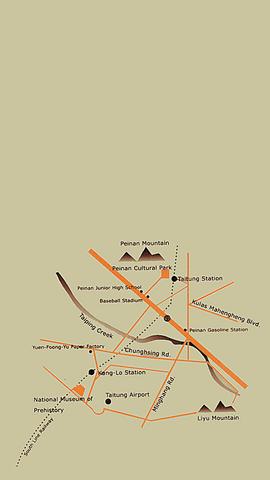
Historical strata
Immediately after the discovery, archeologists from National Taiwan University descended upon the site and raced to save it from destruction. At the same time, many organizations and private individuals began calling for the long-term preservation of the site. Their efforts began to bear fruit in 1986 when the area was set aside to be protected for further archeological study and with the hopes of promoting tourism to the area.
Aside from the scholars, there were plenty of other people also interested in tourists and the dollars they would bring.
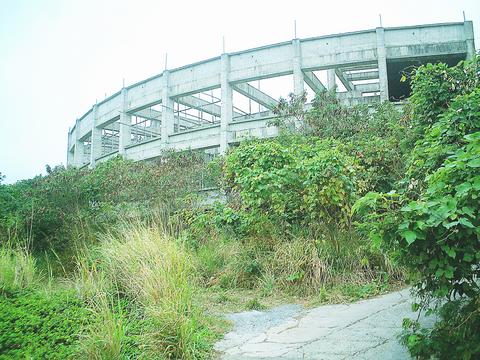
PHOTO: DAVID MOMPHARD, TAIPEI TIMES
Located at the foot of Peinan Mountain at the highest point of the park is the concrete skeleton of a hotel which Lin Yi-shan (
About the same time Lin was building his hotel, the government began construction on an outdoor amphitheater, gardens and a visitors center for the park. Farmers who cultivate land leading up Peinan Mountain began pressing to have the roads widened so as to draw tourists further up the hill.
Their requests weren't met and the farmers protested. When Peinan Cultural Park was first opened to the public in 1997, protests by local farmers successfully kept tourists away.
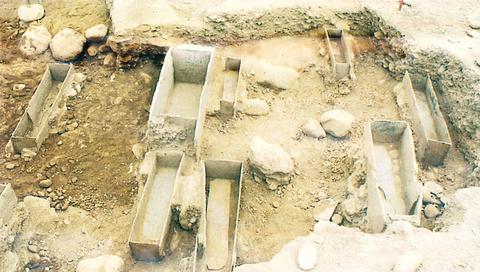
PHOTO COURTESY OF THE NATIONAL PREHISTORY MUSEUM
During construction, there were tales of negligent government contractors digging up ancient pottery with huge landscaping machinery in order to lay flowerbeds.
After all the hullabaloo, the the park was officially reopened last year. It is the first facility in Taiwan where tourists can see the work of archeologists and researchers unearthing buried artifacts.
But the park constitutes only part of the story. With the excitement of the 1980 discovery came increased interest in highlighting not only the ancient Peinan culture, but the histories of all Taiwan's indigenous peoples. A preparation committee was formed in 1990 to draw up plans for what, a decade later, would become the National Museum of Prehistory (
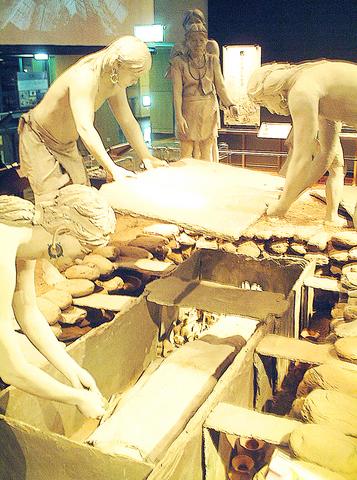
PHOTO: DAVID MOMPHARD, TAIPEI TIMES
Quite inconveniently for tourists, though, the museum and its collection of the prized finds from the Peinan site as well as thousands of other Aboriginal artifacts is located on the opposite side of town, near the Taitung airport.
"It's a very long story," said Lin Chih-hsing (
In order to attract the largest number of visitors to the museum, the Central Government wanted it built in Taipei, but resistance from Taitung County legislators was strong. When a private individual donated sufficient land near the Taitung airport, the museum finally found a home.
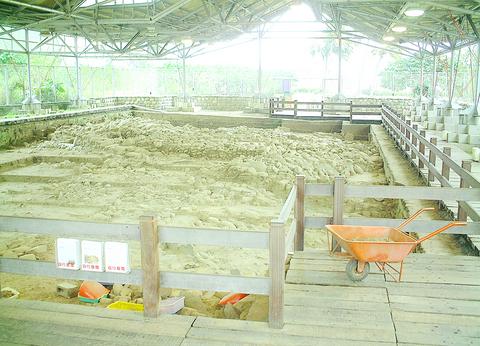
PHOTO: DAVID MOMPHARD, TAIPEI TIMES
But just as the Peinan Cultural Park had been beset by problems, so was the National Museum of Prehistory.
Shortly after the museum was officially opened to the public, one wing of it was heavily damaged by fire. Like the cultural park, the museum didn't reopened until last year.
World heritage
Of course, this eventful history is of little consequence to UNESCO or the groups that help it decide what constitutes a World Heritage site.
Sites are listed within two categories: natural and cultural. The criteria for determining a cultural site is that it be a masterpiece of creative genius, have exerted great architectural influence or -- as with the Peinan site -- be an outstanding example of a traditional way of life representing a certain culture. Aiding UNESCO in its decision is the International Council of Monuments and Sites (ICOMOS). To date, there are 730 sites in 125 countries.
Despite the fact that it was a UNESCO member until it walked out of the UN in 1971, Taiwan has no natural or cultural sites on the World Heritage list.This is due in part to China's political efforts to squelch Taiwan's nominations and in part because of insufficient preservation work on the part of Taiwan's government -- a requirement for World Heritage consideration.
The CCA initially chose 12 sites, but due to the lack of preservation work at seven of the sites only five were forwarded to UNESCO for consideration: Peinan Cultural Park, the Alishan Mountain Railway, Chilishan Forest in Ilan County, Taroko Gorge and Yushan. If any of the sites are approved -- a process that can take up to five years -- the council will have to follow UNESCO regulations on reconstruction and maintenance and secure subsidies for further preservation work.
Although past efforts to make the list have been defeated, Tchen Yu-chiou (
Members of the committee reportedly assured Tchen that some of Taiwan's cultural and natural heritage sites are worthy of attention as world assets.
"The literature at the culture park and the Prehistory Museum reads: `We live on ancient land,'" said the museum's Lin. "If this attitude of inheritance and custodianship is promoted not just by archeologists and cultural workers, but by farmers and hotel owners as well, then Taiwan will have its World Heritage sites."
MORE QUESTIONS THAN ANSWERS
ost of what we know about the people who inhabited what is now Peinan Township, Taitung County is something of a ghost story. Landscape machinery building a new railway station there in 1980 tore through a series of slate graves still holding the skeletons of men, women and children who lived there as long as 5,000 years ago.
While the exhumed graves have taught archeologists and anthropologists a lot about the civilization, the discovery has unearthed a great many more questions, too. We know that they buried their dead under their houses and encased them in sarcophagi with stone lids so that when subsequent family members passed away, the graves could be reopened and bodies could be laid beside their deceased relatives. What scientists don't know is why all of the graves -- hundreds of them found thus far -- are arranged so that their occupants face southwest, or why some graves were built overlapping others.
We've learned about their pottery and stonework from artifacts buried in the graves and from the skulls of their occupants, we have discovered that they removed their cuspids and incisors in a ritual thought to have been a rite of passage to adulthood.
But scientists can only speculate about the most obvious remnant of their civilization; huge stone slabs -- the largest over 3m high -- that stand upright in the ground, each with a large hole chipped out of the center near the top. While most of these slabs have been moved into the museum, they were still standing in their original locations when Japanese anthropologists stumbled upon them in the late 1800s. What they were used for or how they were brought to an area many kilometers away from the nearest slate deposits is a mystery that has died with the ancient people.
Of course, their descendants remain in Taiwan today. The Puyuma have an oral history recounting their origins, but the lack of a written language has deprived these traditions of corroboration.
One such legend holds that the Puyuma originated on the shores of Ruvuahan, which means "the place of origin" in the Puyuma language. The waves brought thousands of bubbles which turned into small particles and from them a large stone was formed. The stone broke and a kind of man emerged whose knees had eyes and a face grew on each side of its head. A man and a woman were born from each of its legs.
A different legend claims that the first male and female Puyuma were born of a bamboo tree planted by a goddess who emerged from the sea.
The Puyuma language itself is one of the last tools scientists have to learn about the culture. Unfortunately, their language, like so much of their ancient culture, will likely one day be heard only in museums.

On April 26, The Lancet published a letter from two doctors at Taichung-based China Medical University Hospital (CMUH) warning that “Taiwan’s Health Care System is on the Brink of Collapse.” The authors said that “Years of policy inaction and mismanagement of resources have led to the National Health Insurance system operating under unsustainable conditions.” The pushback was immediate. Errors in the paper were quickly identified and publicized, to discredit the authors (the hospital apologized). CNA reported that CMUH said the letter described Taiwan in 2021 as having 62 nurses per 10,000 people, when the correct number was 78 nurses per 10,000

As we live longer, our risk of cognitive impairment is increasing. How can we delay the onset of symptoms? Do we have to give up every indulgence or can small changes make a difference? We asked neurologists for tips on how to keep our brains healthy for life. TAKE CARE OF YOUR HEALTH “All of the sensible things that apply to bodily health apply to brain health,” says Suzanne O’Sullivan, a consultant in neurology at the National Hospital for Neurology and Neurosurgery in London, and the author of The Age of Diagnosis. “When you’re 20, you can get away with absolute

May 5 to May 11 What started out as friction between Taiwanese students at Taichung First High School and a Japanese head cook escalated dramatically over the first two weeks of May 1927. It began on April 30 when the cook’s wife knew that lotus starch used in that night’s dinner had rat feces in it, but failed to inform staff until the meal was already prepared. The students believed that her silence was intentional, and filed a complaint. The school’s Japanese administrators sided with the cook’s family, dismissing the students as troublemakers and clamping down on their freedoms — with

As Donald Trump’s executive order in March led to the shuttering of Voice of America (VOA) — the global broadcaster whose roots date back to the fight against Nazi propaganda — he quickly attracted support from figures not used to aligning themselves with any US administration. Trump had ordered the US Agency for Global Media, the federal agency that funds VOA and other groups promoting independent journalism overseas, to be “eliminated to the maximum extent consistent with applicable law.” The decision suddenly halted programming in 49 languages to more than 425 million people. In Moscow, Margarita Simonyan, the hardline editor-in-chief of the